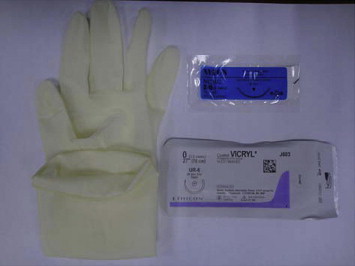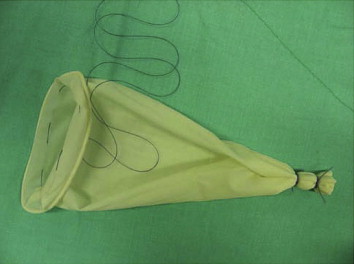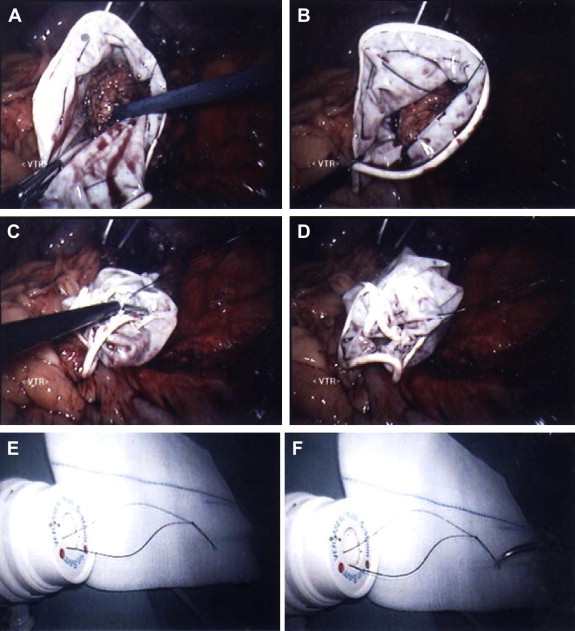Summary
Background
To offer an easily produced and cost-effective specimen retrieval bag that can be used to reduce the cost of laparoscopic surgery.
Methods
From January 2005 to October 2009, 135 patients underwent laparoscopic surgery for adrenalectomy or prostatectomy, during which a homemade specimen retrieval bag was used. The retrieval bag was produced from a large sterile surgical glove, 2-0 nylon thread, and 1-0 RB-1 needle Vicryl thread. A purse-string suture at the opening of the bag was made using the nylon thread, and the bottom of the bag was double-tied using the tail of the Vicryl thread. The bag was introduced into the peritoneal cavity via a 12-mm port, and the specimen was enclosed with the use of two laparoscopic instruments. The bag was then extracted by extending the port incisional wound.
Results
We used a homemade retrieval bag to extract specimens from 110 patients who underwent robot-assisted laparoscopic radical prostatectomy and 25 patients who underwent laparoscopic adrenalectomy. The procedure was performed safely, and no bags were broken. No complications were observed after the operations such as wound infection, ileus, or intestinal adhesion. In our experience, our homemade endobag can be easily used by surgeons to extract specimens from the abdominal cavity. The total cost of hospitalization was also reduced for the patients.
Conclusion
The homemade specimen retrieval bag is cost-effective and useful for the retrieval of intact specimens. It is also easy to make and safe to use.
Keywords
cost-effective;homemade;laparoscopic surgery;retrieval bag
1. Introduction
Laparoscopic surgery was introduced to urology in the early 1990s1 and has become a well-designed alternative to open surgery in recent decades. It is important to extract the surgical specimen from the intra-abdominal cavity during laparoscopic surgery. Many kinds of specimen retrieval systems have been used, but an excellent organ-entrapment system must be easy to handle and allow easy entrapment and good visibility with a minimal number of ports.2 The bags must also demonstrate good resistance when manipulated.2 Many different types of specimen retrieval bags have been described, including the Nadiad bag (Nadiad, India); condom (general marketing use); Modified zipper bag (general marketing use); unpowered bag (general surgery use).3; 4; 5 ; 6
The cost of the specimen retrieval bag must also be taken into consideration. Here, we present a cost-effective, safe, and easily produced bag that can reduce the cost of laparoscopic surgery.
2. Patients and methods
From January 2005 to October 2009, 135 patients underwent laparoscopic surgery using a homemade specimen retrieval bag. The specimen retrieval bag was made of 2-0 nylon thread, 1-0 RB-1 needle Vicryl thread, and a sterile surgical glove (Fig. 1). First, to avoid causing intestinal adhesion or obstruction, we lubricated the sterile surgical glove with normal saline in order to remove the talcum powder. A purse-string suture was made at the opening of the bag using the 2-0 nylon thread, and the bottom of the bag was double-tied with the tail of the 1-0 RB-1 needle Vicryl thread (Fig. 2). The bag functioned like commercially available devices. The remaining 1-0 RB-1 needle Vicryl thread was long enough to close all of the trocar incisional wounds at the end of the operation.
|
|
|
Figure 1. A pair of sterile surgical gloves, 2-0 nylon thread, and 1-0 RB-1 needle Vicryl thread were used to create a homemade specimen retrieval bag. |
|
|
|
Figure 2. The fingers of the sterile glove were cut off and the button of the sterile glove was double-tied using the residual 1-0 Vicryl thread. A purse-string suture was made at the opening of the sterile glove using the 2-0 nylon thread. |
After the homemade retrieval bag was inserted through the 12-mm umbilical trocar site, we used laparoscopic instruments to open the bag and to push the specimen into the bag. The intact specimen was securely enclosed within the bag, and the opening of the bag was intracorporeally closed by tightening the 2-0 nylon purse-string suture. The tail of the nylon thread remained outside of the abdominal cavity (Fig. 3). Consequently, the specimen retrieval bag could be safely handled and was not lost within the abdominal cavity, even as the surgery was in progress. The specimen retrieval bag was extracted at the end of the operation by extending the umbilical port incisional wound.
|
|
|
Figure 3. (A, B) We used laparoscopic instruments to open the homemade retrieval bag and push the specimen into the bag. (C, D) We withdrew the 2-0 nylon thread to close the opening of the bag. (E, F) The tail of the 2-0 nylon thread was kept outside the abdominal cavity and held using a mosquito holder. |
3. Results
The homemade retrieval bag was used during the surgeries of 135 patients, including 110 patients who underwent robot-assisted laparoscopic radical prostatectomy and 25 patients who underwent laparoscopic adrenalectomy. The bag functions like the commercial Endobag (Ethicon). In our experience, all of the retrieval bags were intact after the specimens were extracted from the abdominal cavity. Our homemade retrieval bag is easy to prepare, safe, cost-effective, simple to use, and its learning curve is short. We have demonstrated that specimens can be removed using our homemade retrieval bag. Most importantly, no postoperative complications were observed, such as intestinal obstruction, wound infection, wound metastasis, or the loss of specimens within the abdominal cavity.
All of the various kinds of commercially available specimen retrieval bags are expensive (Table 1). Here, we present a cheap homemade retrieval bag that is made of a sterile fingerless surgical glove, 2-0 nylon thread, and residual 1-0 RB-1 needle Vicryl thread as a safe and cheap alternative. It functions like the commercial Endobag, but reduces the cost of the surgery for the patient. The costs of the items required to make our retrieval bag are listed in Table 2.
| Bag | Company | Cost ($US) |
|---|---|---|
| Endopouch | Ethicon | 35 |
| EndoCatch bag | Ethicon | 75 |
| Pleatman Sac | Abbot Medicals | 28 |
| Ponsky Endosac | U.S. Endoscopy | 60 |
| Nadiad bag | Nadiad, India | 2 |
| Our retrieval bag | 1.25 |
| Item | Cost ($US) |
|---|---|
| Nylon tie | 0.75 |
| Sterile surgical gloves | 0.50 |
| Residual 1-0 RB-1 Vicryl threada | 0 |
a. The 1-0 RB-1 Vicryl thread did not result in any extra costs during surgery.
4. Discussion
Laparoscopic surgery has become a popular technique in recent decades. The most common reasons for its use include the small incisions required, rapid recovery, short hospital stay, very slight bleeding, and reduced postsurgical wound pain. Most people are attracted by these advantages, so the evolution of minimal invasive surgery has been rapid. It is also important that the specimen be removed from the abdominal cavity after laparoscopic surgery, and many commercial specimen bags (such as the Endobag, EndoCatch bag and Endopouch (Ethicon); Pleatman Sac (Abbot Medicals); Ponsky Endosac (U.S. Endoscopy) have been developed.3 However, these retrieval bags come in only one size and are expensive. It is also sometimes difficult to intracorporeally handle the retrieval bags because of the limited space available in the surgical field.
In the past, several self-designed retrieval bags, including surgical gloves, condoms, and reclosable zipper bags, have been used, but they do not include a purse-string closure mechanism around the opening of the bag.4; 5; 6; 7 ; 8
Our homemade retrieval bag was constructed from 2-0 nylon thread, 1-0 RB-1 needle Vicryl thread, and a sterile surgical glove. An illustration of the finished product is shown in Fig. 1. Our homemade bag is cost-effective and easy to make, and has several other advantages. First, it is easy to close the opening of the bag by stretching the tail of the 2-0 nylon thread outside the abdominal cavity (Fig. 3), and the specimen retrieval bag can be safely pulled from the umbilical trocar site by withdrawing the 2-0 nylon thread. Second, the 2-0 nylon thread across the umbilical trocar is left outside of the abdominal cavity; therefore, the thread does not hinder the manipulation of the scope. Consequently, a new trocar sites do not need to be created. Third, some authors have reported that when a surgical glove comes into contact with the peritoneal fluid, it collapses, making collection of the specimen difficult.5 We used normal saline solution to wash the sterile surgical glove in order to remove the talcum powder, making it easy to use laparoscopic instruments to open the bag and push the specimen into it. No intestinal adhesion was found to have occurred after the operation.
Our specimen retrieval bag has the same advantages as commercial Endobags, including minimized contamination of the abdominal cavity and the surgical wound tract when removing the specimen. In our experience, our homemade retrieval bag can be safely pulled from abdominal cavity, and the bag never broke during manipulation. Most importantly, our retrieval bag is an extremely cost-effective, easily made, artificial product, which obviates any extra cost to the patient. We recommend the use of our homemade specimen retrieval bag for use in patients undergoing laparoscopic surgery during which specimens must be removed.
References
- 1 E.M. McDouggall, R.V. Clayman; Advances in laparoscopic urology, part 1. History and development of procedures; Urology, 43 (1994), pp. 420–426
- 2 J. Rassweiler, C. Stock, T. Frede, et al.; Organ retrieval system for endoscopic nephrectomy: A comparative study; J Endourol, 12 (1998), pp. 325–333
- 3 P. Arvind, G.E. Gotov, S. Mishra, et al.; Novel cost-effective specimen retrieval bag in laparoscopy: Nadiad bag; Urology, 75 (2010), pp. 1213–1216
- 4 S.C. Chung, M.K. Li, A.K. Li; Lost stone during laparoscopic cholecystectomy: retrieval using a condom; HPB Surg, 7 (1993), pp. 67–68
- 5 A. Weber, J.A. Vazquez, S. Valencia, J. Cueto; Retrieval of specimens in laparoscopy using reclosable zipper-type plastic bags; Surg Laparosc Endosc, 8 (1998), pp. 457–459
- 6 S.L. Wai, P.S. Ng, P.M. Yuen; Morcellation inside a zipper bag pouch: an efficient and safe way to retrieve a large, solid ovarian mass laparoscopically; J Gynecol Surg, 23 (2007), pp. 31–36
- 7 Y. Hiroshi, O. Kazuyuki, K. Masakatsu, et al.; Use of non-powder surgical glove for extraction of gallbladder in laparoscopic cholecystectomy; Digest Endosc, 15 (2003), pp. 315–319
- 8 P.M. Yuen, M.S. Rogers; Laparoscopic removal of ovarian cysts using a zipper storage bag; Acta Obstet Gyncol Scand, 73 (1994), pp. 829–831
Document information
Published on 26/05/17
Submitted on 26/05/17
Licence: Other
Share this document
Keywords
claim authorship
Are you one of the authors of this document?


